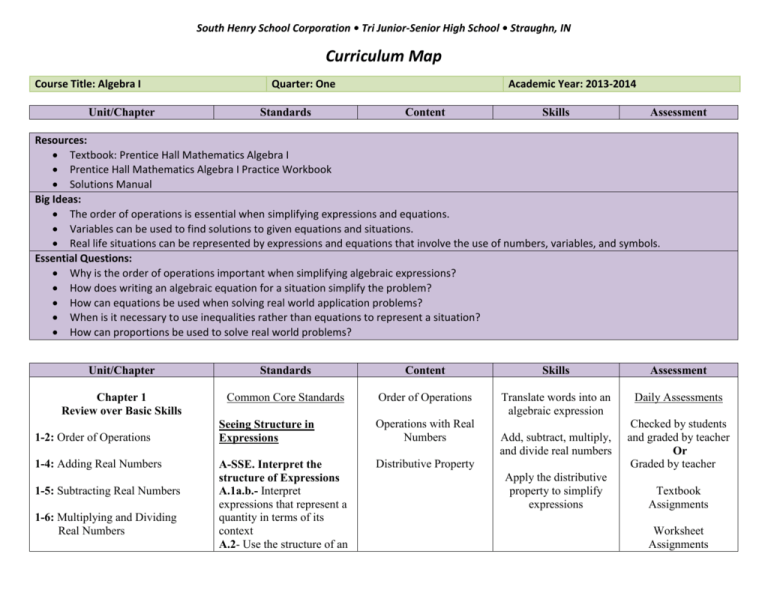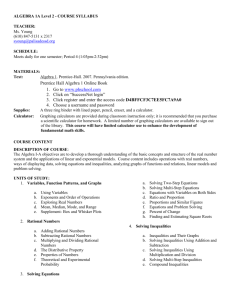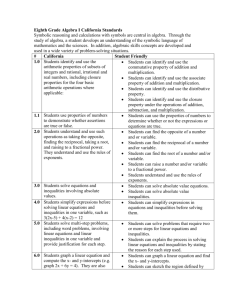Algebra 1st Quarter - South Henry School Corporation / Overview
advertisement

South Henry School Corporation • Tri Junior-Senior High School • Straughn, IN Curriculum Map Course Title: Algebra I Unit/Chapter Quarter: One Standards Academic Year: 2013-2014 Content Skills Assessment Resources: Textbook: Prentice Hall Mathematics Algebra I Prentice Hall Mathematics Algebra I Practice Workbook Solutions Manual Big Ideas: The order of operations is essential when simplifying expressions and equations. Variables can be used to find solutions to given equations and situations. Real life situations can be represented by expressions and equations that involve the use of numbers, variables, and symbols. Essential Questions: Why is the order of operations important when simplifying algebraic expressions? How does writing an algebraic equation for a situation simplify the problem? How can equations be used when solving real world application problems? When is it necessary to use inequalities rather than equations to represent a situation? How can proportions be used to solve real world problems? Unit/Chapter Standards Content Skills Assessment Chapter 1 Review over Basic Skills Common Core Standards Order of Operations Translate words into an algebraic expression Daily Assessments 1-2: Order of Operations 1-4: Adding Real Numbers 1-5: Subtracting Real Numbers 1-6: Multiplying and Dividing Real Numbers Seeing Structure in Expressions Operations with Real Numbers A-SSE. Interpret the structure of Expressions A.1a.b.- Interpret expressions that represent a quantity in terms of its context A.2- Use the structure of an Distributive Property Add, subtract, multiply, and divide real numbers Apply the distributive property to simplify expressions Checked by students and graded by teacher Or Graded by teacher Textbook Assignments Worksheet Assignments South Henry School Corporation • Tri Junior-Senior High School • Straughn, IN Curriculum Map Course Title: Algebra I Unit/Chapter 1-7: The Distributive Property Chapter 2 Solving Equations 2-1: Solving One-Step Equations 2-2: Solving Two-Step Equations 2-3: Solving Multi-Step Equations 2-4: Solving Equations with Variables on both Sides 2-6: Solving Formulas for a Specific Variable 2-7: Using Measures of Central Tendency Quarter: One Standards Academic Year: 2013-2014 Content Skills Solving Equations that contain one variable Solve one step equations by adding, subtracting, multiplying, or dividing. expression to identify ways to rewrite it Num/Quantity, Quantities N-Q. Reason quantitatively and use units to solve problems. A.1. Use units as a way to understand problems and to guide the solution of multistep problems; choose and interpret units consistently in formulas; choose and interpret the scale and the origin in graphs and data displays. Creating Equations A-CED. Create equations that describe numbers or relationships A.1- Create equations and inequalities in one variable and use them to solve problems. Include equations arising from linear and quadratic functions, and simple radical and exponential functions. A.4. Rearrange formulas to Assessment Observations Solve formulas for a specified variable Mean, Median, Mode, Range Stem-and-leaf plots In- Class Oral Responses Solve two step equations that involve one variable and two operations. Weekly/Bi-Weekly Solve equations in one variable that contain a variable on both sides of the equation. Quizzes Combine like terms to simplify expressions and equations. Solve formulas for a specified variable Find the mean, median, mode, and range of a set of data and create a stem-and-leaf plot Find a missing data value when given other data and the mean Notes Check Tests South Henry School Corporation • Tri Junior-Senior High School • Straughn, IN Curriculum Map Course Title: Algebra I Unit/Chapter Chapter 3 Solving Inequalities Quarter: One Standards highlight a quantity of interest, using the same reasoning as in solving equations. 3-1: Inequalities and Their Graphs 3-2: Solving Inequalities Using Addition and Subtraction 3-3: Solving Inequalities Using Multiplication and Division 3-4: Solving Multi-Step Inequalities 3-5: Compound Inequalities 3-6 Part 1: Solving Absolute Value Equations 3-6 Part 2: Solving Absolute Value Inequalities Reasoning with Equations and Inequalities A-REI. Understand solving equations as a process of reasoning and explain the reasoning A.1. Explain each step in solving a simple equation as following from the equality of numbers asserted at the previous step, starting from the assumption that the original equation has a solution. Construct a viable argument to justify a solution method. A-REI. Solve equations and inequalities in one variable. B.3- Solve linear equations and inequalities in one variable, including equations with coefficients represented by letters Academic Year: 2013-2014 Content Skills Graphing Inequalities Graph inequalities that contain one variable One, Two, and Multi-Step Inequalities Inequalities with a variable on both sides Compound Inequalities Absolute Value Equations and Inequalities Solve inequalities that contain one variable by adding, subtracting, multiplying, or dividing Solve inequalities that involve multiple operations. Solve inequalities in one variable that contains a variable on both sides of the inequality Solve and graph “and” and “or” compound inequalities Solve absolute value equations in order to find the two solutions Solve and graph absolute value inequalities Assessment South Henry School Corporation • Tri Junior-Senior High School • Straughn, IN Curriculum Map Course Title: Algebra I Unit/Chapter Word Problems Equations and Problem Solving Quarter: One Academic Year: 2013-2014 Standards Content Skills Standards for Mathematical Practice Application problems that involve the use of one variable Solve real world application problems that require students to define a variable, write and equation, solve the equation, and write the answer in a sentence. 2-2: Two Step 2-3: Multi- Step 2-4: Variable on Both Sides 2-5: Problem Solving Word Problems Equations and Problem Solving MP1: Make sense of problems and persevere in solving them. MP2: Reason abstractly and quantitatively. MP3: Construct viable arguments and critique the reasoning of others. MP4: Model with mathematics. MP5: Use appropriate tools strategically. MP6: Attend to precision. MP7: Look for and make use of structure. MP8: Look for and express regularity in repeated reasoning. Application problems that involve writing equations in one variable, but with the variable on both sides of the equation Find the length and width of a rectangle when given that the length is a certain measure more than the width Application problems that involve the use of one variable 2-2: Two Step 2-3: Multi- Step 2-4: Variable on Both Sides 2-5: Problem Solving Find a specific number of consecutive integers that add to a given sum Application problems that involve writing equations in one variable, but with the variable on both sides of the equation Solve real world application problems that require students to define a variable, write and equation, solve the equation, and write the answer in a sentence. Find a specific number of consecutive integers that add to a given sum Assessment South Henry School Corporation • Tri Junior-Senior High School • Straughn, IN Curriculum Map Course Title: Algebra I Unit/Chapter Quarter: One Standards Academic Year: 2013-2014 Content Skills Find the length and width of a rectangle when given that the length is a certain measure more than the width Chapter 4 Solving and Applying Proportions Simplifying ratios Cross multiplication 4-1: Ratios and Proportions Simplify ratios that will be necessary to get an answer in its simplest form Similar Figures 4-2: Proportions and Similar Figures Percents 4-3: Using Proportions to Solve Percent Problems 4-4: Percent Of Change 4-5: Applying Ratios to Probability 4-6: Probability of Compound Events Solve proportions using the cross multiplication method Percent of Change Probability Find missing sides of similar figures by setting up and solving a proportion Apply proportions to real world problems (Finding heights when given a length of a shadow and other relevant information) Apply proportions to solve problems involving percent and Assessment South Henry School Corporation • Tri Junior-Senior High School • Straughn, IN Curriculum Map Course Title: Algebra I Unit/Chapter Quarter: One Standards Academic Year: 2013-2014 Content Skills percent change Determine whether a percent of change is a percent increase or decrease Use ratios to determine probability Assessment







